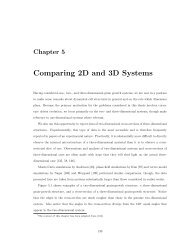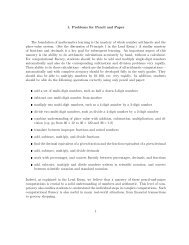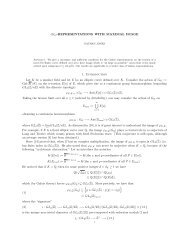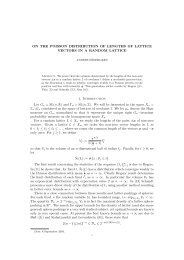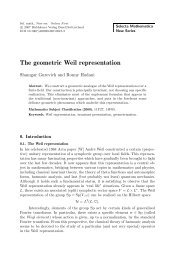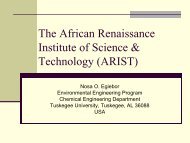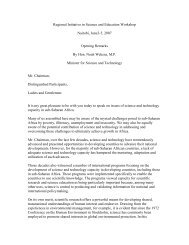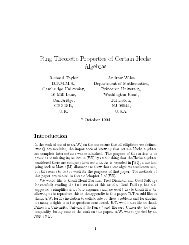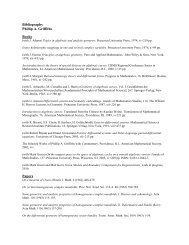The Nelson Mandela African Institute of Science and Technology ...
The Nelson Mandela African Institute of Science and Technology ...
The Nelson Mandela African Institute of Science and Technology ...
You also want an ePaper? Increase the reach of your titles
YUMPU automatically turns print PDFs into web optimized ePapers that Google loves.
<strong>The</strong> <strong>Nelson</strong> <strong>M<strong>and</strong>ela</strong><strong>African</strong> <strong>Institute</strong> <strong>of</strong> <strong>Science</strong> <strong>and</strong><strong>Technology</strong>, Arusha(AIST-Arusha)ByBurton LM Mwamila,NM AIST-ArushaSeptember 2009
• Government <strong>of</strong> Tanzania• AIST-Arusha Task Force• East <strong>African</strong> Community Secretariat in Arusha• Wole Soboyejo <strong>and</strong> Nosa Egiebor <strong>of</strong> ASC &ARIST• Philip Griffiths <strong>and</strong> Arlen Hastings SIG <strong>and</strong> ISAB• Arlen Hastings <strong>of</strong> ISAB, ASC & ARIST• Colleagues at NM AIST-Arusha, Alfonce Dubi<strong>and</strong> Dunstan Shemweta NMI Board
Introduction
• Jim Wolfensohn meeting with <strong>African</strong> leaders(including <strong>Nelson</strong> <strong>M<strong>and</strong>ela</strong>), around 2001/02• <strong>Nelson</strong> <strong>M<strong>and</strong>ela</strong> suggested to Jim that world class<strong>African</strong> <strong>Institute</strong>s <strong>of</strong> <strong>Science</strong> & <strong>Technology</strong>(AISTs) in sub-Saharan Africa are perhaps Africa’sgreatest need:– Similar to the Indian <strong>Institute</strong>s <strong>of</strong> <strong>Science</strong> <strong>and</strong><strong>Technology</strong> (IITs)– Other comparable institutions include MIT, Cal Tech,Cambridge, Stanford, Princeton, etc• Frannie Leautier, Vice President <strong>of</strong> the World Bank,was given the task <strong>of</strong> making this happen
• Hippolyte F<strong>of</strong>ack, an <strong>African</strong> WBI <strong>of</strong>ficial, wascharged with developing the concept in collaborationwith some <strong>African</strong> in the diaspora;• <strong>The</strong> AISTs are being developed into a network worldclassinstitutions, to promote excellence through acompetitive process;• <strong>The</strong> AISTs are expected to play a leading role in thepromotion <strong>of</strong> sciences within the continent, throughstrong linkages with existing nationaluniversities, <strong>and</strong> research institutions;• Heads <strong>of</strong> <strong>African</strong> States met in Abuja in January2005 <strong>and</strong> agreed to establish 4 AISTs - for Western,Eastern, Central <strong>and</strong> Southern Africa.
• Knowledge creation; <strong>and</strong>• Application <strong>of</strong> knowledge foreconomic growth <strong>and</strong> diversification.
To catalyze the development <strong>of</strong> world classscience <strong>and</strong> technology in Africa in ways that canstimulate economic growth <strong>and</strong> generateemployment, <strong>and</strong> turn brain drain into brain gain;To provide the best facilities for graduate <strong>and</strong>post-doc studies <strong>and</strong> research;To bridge between research <strong>and</strong> industrialdevelopment through:strong link with industry for technology transfer; <strong>and</strong>the establishment <strong>of</strong> technology parks around theAISTs for seeding innovations, with technology-cumbusinessincubators for spin-<strong>of</strong>f technological firms
NM AIST-Arusha
• Arusha was selected as one <strong>of</strong> 4 earlyAISTs• Government <strong>of</strong> Tanzania quicklyresponded by <strong>of</strong>fering 3285 acres <strong>of</strong> atKarangai, in the outskirts <strong>of</strong> Arusha• Former CAMARTEC premises (ca 199acres) were also h<strong>and</strong>ed over to serve asstart-up campus for NM AIST-Arusha onOctober 31, 2008
<strong>The</strong> United Republic <strong>of</strong> Tanzania
• Former CAMARTEC Site– Size: 199 acres <strong>of</strong> l<strong>and</strong>– Distance from Arusha City Centre, 16 km– Distance to Kilimanjaro Airport (KIA), 35 km– Distance to main road, 5 km– Distance to Karangai, 20 km• Karangai Site– Size: 3,285 acres <strong>of</strong> l<strong>and</strong>– Distance from Arusha City Centre, 36 km– Distance to KIA, 55 km via former CAMARTEC
Organization StructureCHANCELLORCOUNCILVICECHANCELLORInternational AdvisoryBodies (ISAB, ARIST)Regional ScientificCommittee (RSC)DEPUTY VCACADEMICDEPUTY VCADMINISTRATIONDeanSchool 1DeanSchool 2DeanSchool 3DeanSchool 4HeadDepartment
To become a world-class institution <strong>of</strong>higher learning dedicated to the pursuit<strong>and</strong> promotion <strong>of</strong> excellence in science<strong>and</strong> engineering <strong>and</strong> their applicationsfor economic growth <strong>and</strong> sustainabledevelopment in Africa.
To deliver <strong>and</strong> promote high quality <strong>and</strong>internationally competitive teaching <strong>and</strong>learning, research <strong>and</strong> innovation, <strong>and</strong>public service in science, engineering <strong>and</strong>technology for enhanced value addition topeople <strong>and</strong> natural resources, <strong>and</strong>entrepreneurship to stimulate <strong>and</strong> catalyzeeconomic growth <strong>and</strong> sustainabledevelopment in Africa.
NM AIST-Arusha will:• Seek to stimulate <strong>and</strong> catalyzeintensification <strong>of</strong> agricultural production,<strong>and</strong> value addition to natural products.• Emphasize linkage to society <strong>and</strong> the localindustry, <strong>and</strong> scientific <strong>and</strong> technologicalresponse to local needs.• Strive for a combination <strong>of</strong> strong localconnections <strong>and</strong> strong global connections.
• Four main fields <strong>of</strong> training– Basic <strong>Science</strong>s– Engineering <strong>and</strong> <strong>Technology</strong>– Life <strong>Science</strong>s <strong>and</strong> Bio-Engineering– Business <strong>and</strong> Humanities as service courses• Focus on postgraduate training <strong>and</strong> postdoctoralresearch
• Materials <strong>Science</strong> & Engineering• Bio-<strong>Science</strong>s & Engineering (life sciences)• Water <strong>and</strong> Environmental <strong>Science</strong> &Engineering• Mathematics <strong>and</strong> Computational <strong>Science</strong>& Engineering (incl. ICT)• Humanities <strong>and</strong> Business– Management <strong>and</strong> Entrepreneurship– Innovation Management <strong>and</strong>Competitiveness (incl. IPR)– Law, Philosophy <strong>and</strong> Ethics– Communication Skills
• Core permanent <strong>and</strong> contract facultyrecruited competitively from within <strong>and</strong>outside EA Region• Pool <strong>of</strong> visiting faculty from the Diasporacoordinated by ARIST• Students to be admitted from the EARegion, <strong>and</strong> SSA generally.
• Capital development funds from:– Government <strong>of</strong> Tanzania– Multilateral sources in form <strong>of</strong> grants/s<strong>of</strong>t loans– Bilateral sources in form <strong>of</strong> grants/s<strong>of</strong>t loans• Operational funds from student fees• Research funds sought through winningproposals• An Endowment Fund for Excellence• Buy-in contributions by EA member states
• Endowment Fund for Excellenceestablished through contributions frompublic <strong>and</strong> private sources world-wide to:– Allow dual funding, <strong>and</strong> hence mitigate overdependenceon one country– Sustain high quality education– Ensure long-term financial sustainability;• Student Fees;• Student loans managed by Bank.
• World Bank initially through the WorldBank <strong>Institute</strong>• <strong>African</strong> Development Bank• University <strong>of</strong> California System• Princeton University System• State University <strong>of</strong> New Jersey (RUTGERS)• ISAB Chaired by Phillip Griffiths• ASC/ARIST Chaired by Wole Soboyejo
Activity Date RemarksSubmission <strong>of</strong> request toWorld BankDec ‘08WB reaffirmed commitmentto support AIST-ArushaRegistration <strong>of</strong> AIST-Arusha April ‘09 Registration granted byTCUAppointment <strong>of</strong> Management<strong>of</strong> AIST-ArushaRehabilitation <strong>and</strong> face-lifting<strong>of</strong> start-up campusDevelopment <strong>of</strong> infrastructureto the two campus sitesJuly ‘09Oct ‘09InprogressRehabilitation <strong>and</strong>operationalizationTo be managed by PPLCoordinated by Inter-Ministerial Committee (IMC)Curriculum development -ditto- Supported by ARISTStaff <strong>and</strong> faculty recruitment Soon ARIST & ISAB to assistLaunching <strong>of</strong> AIST-Arusha Early 2010Commencement <strong>of</strong> training Early 2010
• RISE <strong>and</strong> NM AIST Arusha have a lot incommon.• Collaboration between them has thepotential <strong>of</strong> benefitting Sub-sahara Africaa great deal
Thank you very much !Asanteni Sana !Website: www.nm-aist.ac.tz



